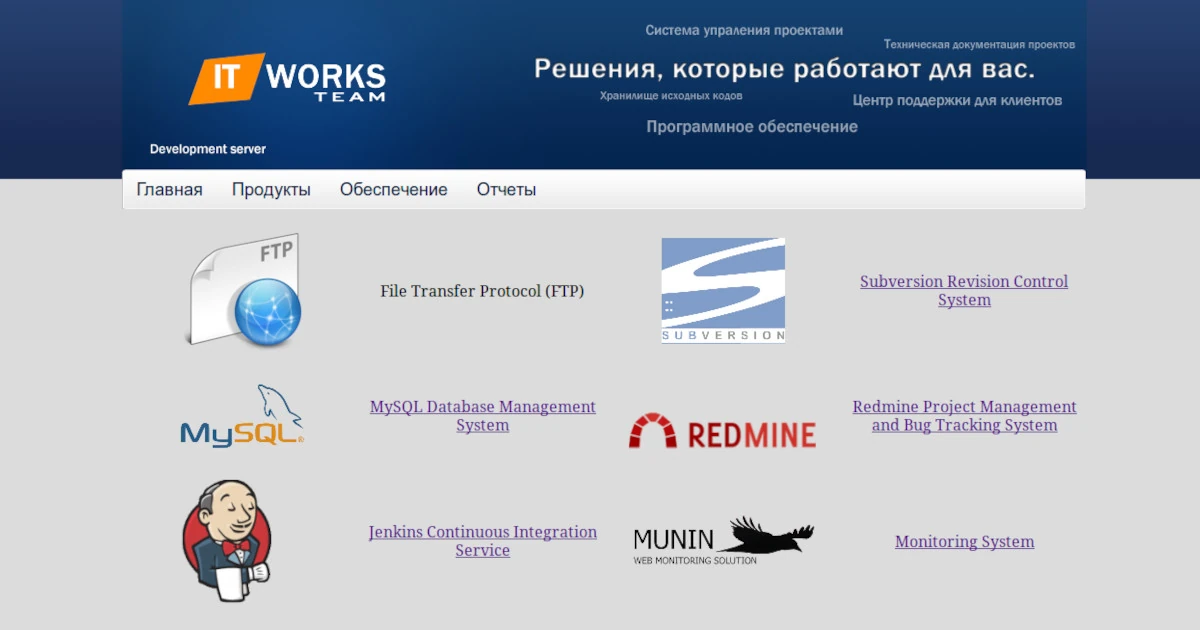Creating a development server
Project of setting up a self-hosted development server with useful tools.
Story
In the period 2011-2013 I was working on various personal and customer projects and it became more and more difficult to manage the source code and all related documentation for them. At that time I became familiar with the Unix system and wanted to learn more about it. My goal was to set up a development server that would help me manage source code repositories, build environments, issue tracking, and more in an organized way, and to share these tools with other people I work with. I want to set it up on my own hardware so that I can learn server administration as well.
Hardware
I tried to keep the setup as light and power efficient as possible while still being able to run the necessary software. The server was a 3Q-Sign Nettop PC with Intel Atom D525, 4GB SO-DIMM DDR3 RAM, SATA HDD, Gigabit Ethernet, 802.11bgn Wi-Fi and a 65 watt power supply, which is not very powerful but very economical. The PC is connected to a Must PowerAgent 1060 LCD UPS, which allows it to work for hours in the event of a power outage.
Monitor battery capacity
To prevent data loss or damage, I configured Network UPS Tools (NUT) monitoring to check the UPS battery voltage levels and percent charged. The configuration required running a few tests to determine the high and low voltage thresholds used to trigger an emergency shutdown in the event of a power failure if the battery level drops below the low threshold.
1
2
3
4
5
6
default.battery.voltage.high = 27.4
default.battery.voltage.low = 21.8
; battery.voltage - battery.voltage.low
; battery.charge = -------------------------------------------- x 100 %
; battery.voltage.high - battery.voltage.low
Monitor internet availability
After experiencing some problems with Internet availability due to intermittent router problems, I wrote a simple bash script to periodically check for Internet connectivity and automatically reboot the router if the connection is lost.
1
2
3
4
5
6
7
8
#!/bin/sh
if [ "`ping 8.8.8.8 -c 5 -a | grep ttl`" == "" ]; then
echo "Looks like internet is down. Rebooting the router..."
wget --http-user=admin --http-password=6vT9xcm2ceXuF33 --output-document=/dev/null http://192.168.1.1/rebootinfo.cgi
else
echo "Internet works."
fi
Software
I chose Ubuntu Server LTS as the operating system because of its stability and large community support. Some of the major software installed are
- Apache web server
- File transfer server (FTP)
- MySQL database management system
- Jenkins continuous integration service with Windows build agent running in VirtualBox
- Subversion (SVN) source control system
- Redmine project management and bug tracking system
- Munin web monitoring solution
- Mail server (working with Postfix and Gmail service)
Website
To avoid having to remember all the links and to have a single place where I can access all the tools and reports about server health, I set up a simple web site with Apache. The site is written in PHP and uses the MySQL database for data storage.
Backups
To automate the process of backing up important files and databases, I wrote bash scripts. They are run by a crontab schedule.
1
2
3
4
5
6
#!/bin/sh
backup_files="/var/spool/mail /etc /var/log /var/svn /var/www"
dest="/home/kungfux/backup/fs/"
archive_file=$(date +"%d-%m-%Y-%T")".tar.gz"
tar czf $dest/$archive_file $backup_files
1
2
3
4
5
6
7
8
9
10
11
12
13
14
15
16
17
#!/bin/sh
MUSER="root"
MPASS="fThbSpgEPQtj4r4"
MHOST="localhost"
MYSQL="$(which mysql)"
MYSQLDUMP="$(which mysqldump)"
BAK="/home/kungfux/backup/mysql"
GZIP="$(which gzip)"
NOW=$(date +"%d-%m-%Y")
DBS="$($MYSQL -u $MUSER -h $MHOST -p$MPASS -Bse 'show databases')"
for db in $DBS
do
FILE=$BAK/$db.$NOW-$(date +"%T").gz
$MYSQLDUMP -u $MUSER -h $MHOST -p$MPASS $db | $GZIP -9 > $FILE
done
Build agents
To facilitate automated build and test, I configured Jenkins to use a VirtualBox VM running Windows as the build agent. However, I needed to ensure that the VM would automatically start and stop when the server was shut down. This required learning more about System-V. I wrote a separate post about this task earlier.
Conclusion
- Having a development server allowed me to manage projects in an organized way and learn new skills.
- Setting it up with open source software like Ubuntu, Apache, MySQL, Jenkins, SVN, Redmine, etc. kept costs down while providing powerful tools for development and collaboration.
- This experience has been useful for my future projects, including smart home automation and home network administration, as well as a general understanding of how things work.

